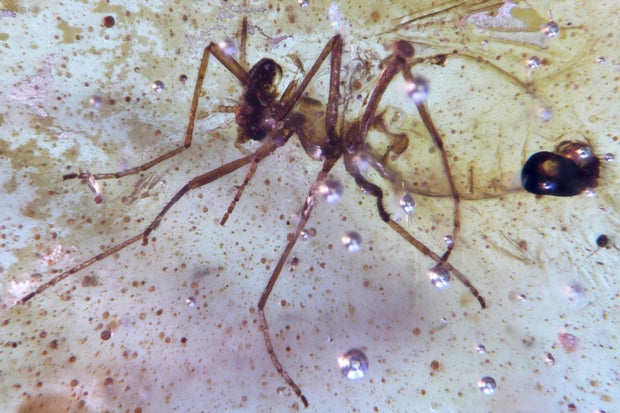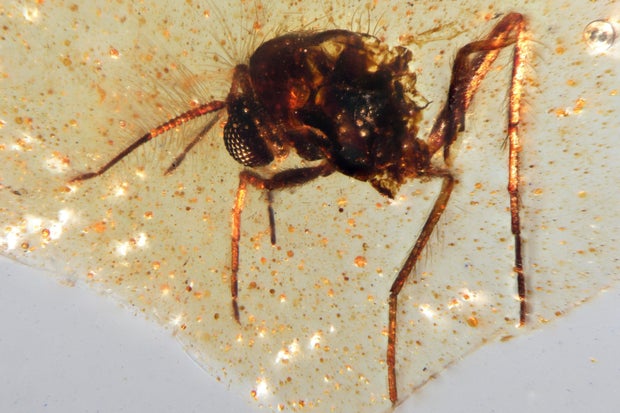Scientists have discovered prehistoric insects preserved in amber for the first time in South America, providing a fresh glimpse into life on Earth at a time when flowering plants were just beginning to diversify and spread around the world.
Many of the specimens found at a sandstone quarry in Ecuador date to 112 million years ago, said Fabiany Herrera, curator of fossil plants at the Field Museum in Chicago and co-author of the study published Thursday in the journal Communications Earth and
Environment. At least six types of arthropods were found preserved, according to the study.
Almost all known amber deposits from the past 130 million years have been in the Northern Hemisphere, and it's long been "an enigma" that scientists have found few in southern regions that once comprised the supercontinent Gondwana, said David Grimaldi, an entomologist at the American Museum of Natural History who was not involved in the discovery.
 This photo provided by researchers in September 2025 shows a Diptera Brachycera fly of the family Dolichopodidae (long-legged flies) trapped in a Cretaceous-era amber sample discovered in Ecuador.
Mónica Solórzano-Kraemer/AP
This photo provided by researchers in September 2025 shows a Diptera Brachycera fly of the family Dolichopodidae (long-legged flies) trapped in a Cretaceous-era amber sample discovered in Ecuador.
Mónica Solórzano-Kraemer/AP
This marks the first time researchers have identified ancient beetles, flies, ants and wasps in fossilized tree resin in South America, said Ricardo Pérez-de la Fuente, a paleoentomologist at the Oxford University Museum of Natural History, who also was not involved in the new study.
"Amber pieces are little windows into the past," Pérez-de la Fuente said, adding that the discovery will help researchers understand the evolving interactions between flowering plants and insects that lived during the era of the dinosaurs.
The researchers uncovered hundreds of fragments of amber, some containing ancient insects, pollen and tree leaves, at a sandstone quarry in Ecuador that's on the edge of what is today the Amazon
basin.
Two types of amber were discovered, according to the study: There was a more common form of amber found around the roots of resin-producing plants, and a rarer form of the material formed from resin exposed to air. The amber formed around the roots did not hold any specimens, the study said.
 This photo provided by researchers in September 2025 shows a Diptera Nematocera fly of the family Chironomidae (non-biting midges) trapped in a Cretaceous-era amber sample discovered in Ecuador.
Mónica Solórzano-Kraemer/AP
This photo provided by researchers in September 2025 shows a Diptera Nematocera fly of the family Chironomidae (non-biting midges) trapped in a Cretaceous-era amber sample discovered in Ecuador.
Mónica Solórzano-Kraemer/AP
"A different kind of forest"
The discoveries provide evidence that the area was once a "humid, resinous forest ecosystem," according to the study.
But today's rainforest is much different from what dinosaurs roamed through, Herrera said. Based on an analysis of fossils in the amber, the ancient rainforest contained species of ferns and conifers, including the unusual Monkey Puzzle Tree, that no longer grow in Amazonia.
"It was a different kind of forest," said Herrera.
The amber deposits were previously known to geologists and miners who worked at the Genoveva quarry. Study co-author Carlos Jaramillo at the Smithsonian Tropical Research Institute first heard of them about a decade ago and set out to find the exact location, aided by geology field notes.
 This photo provided by researchers in September 2025 shows a Diptera Nematocera fly of the family Chironomidae (non-biting midges) trapped in a Cretaceous-era amber sample discovered in Ecuador.
Mónica Solórzano-Kraemer/AP
This photo provided by researchers in September 2025 shows a Diptera Nematocera fly of the family Chironomidae (non-biting midges) trapped in a Cretaceous-era amber sample discovered in Ecuador.
Mónica Solórzano-Kraemer/AP
"I went there and realized this place is amazing," Jaramillo said. "There's so much amber in the mines," and it's more visible in the open quarry than it would be if hidden under dense layers of vegetation.
Researchers will continue to analyze the amber trove to learn more about Cretaceous-era biodiversity — including the insects that contributed to evolution by feeding on flowering plants. "Amber tends to preserve things that are tiny," said Grimaldi.
"It's the time when the relationship between flowering plants and insects got started," said Pérez-de la Fuente. "And that turned out to be one of the most successful partnerships in nature."


















































